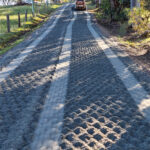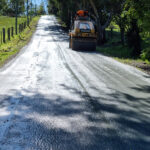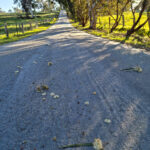Busy Diggers Driveway Resurfacing Story
- Product: SoilGlu
- Job Type: Trades
- Company: Busy Digger, Rural Landscaping Company
- Website: https://www.busydigger.com.au , https://www.rurallandscapingcompany.com.au
- Authorised Applicator
- SoilGlu (Gluon)
Location: Jarrahdale WA
Date: 10-11 August 2022
Project: Driveway resurfacing on a rural property with existing steep road base driveway section approx. 180m long with an 11% incline.
Problem
Long steep rural driveways, particularly those constructed from compacted aggregates, can suffer from erosion and loss of compaction. In this case, the driveway had become corrugated through its steepest section. Heavy use by trucks and farm equipment, 4wd vehicles and light front-wheel drive vehicles lead to the surface breaking up when traction is lost. This loss of traction soon developed into a series of corrugations, making the issue worse. Winter months further compromise this uncompacted finish with rain less likely to sheet off, soak in and soften the road base. Instead, the rain carries the fines away, leading to ruts and potholes.
Remedy
The solution we found is driveway resurfacing which involves stabilising the road material with Gluon. This will make the path both bound and waterproof, ensuring its longevity. Since the road had good stormwater (spoon) drains on both sides, a simple crown running down the centre design was sufficient to split water volumes left and right.
Method & Application
This rural driveway project involved ripping the existing road base driveway to remove corrugations, correcting levels and binding the new finishing course materials. New aggregate was pushed in and conditioned at an average 60-65mm lift. For this application, we mixed Gluon through the new material at a depth of 50mm +/-. Gluon was applied at a rate of 3ltr/m3 by gravity feed dribble bar at the prescribed dilution rate. Several passes were undertaken to ensure the entire application was distributed.
Following this, the Gluon aggregate was mixed by using a rotating soil conditioner to ensure even coverage. We monitor the moisture content at all times to ensure the material is workable, not too dry or too wet. The road was graded to the design and the mixed material was finally trimmed. Compaction was achieved using a vibrating steel drum roller and plate compactor. To improve weather resistance, a Gluon sealer coat was applied to the finished surface some hours later.
Application Notes: Normal water binding methods (adding water) do not apply when using Gluon so material workability must be more or less correct ahead of the final trim. Water is applied via the drum roller which is essential to eliminate material sticking to the drum and seal the surface. During/after rolling the surface will begin to dry and set quickly. All machines need to be removed from the treated area while tacky and left to set.
Result
TBC. The finish and wear will be monitored over the coming weeks and months. The Gluon stabilised driveway surface is expected to be less likely to break up when there is traction loss as the aggregates are bound. We expect a finish that is less permeable by sealing the aggregate with Gluon, in this way ensuring the fines remain tightly bound and driveway hardness is not compromised by sheet flow during rain events. We hope to see a significant improvement in the wear and longevity of the finish between resurfacing events.





